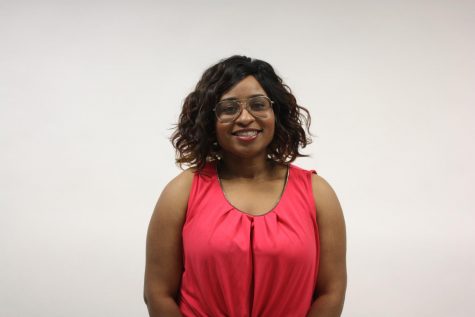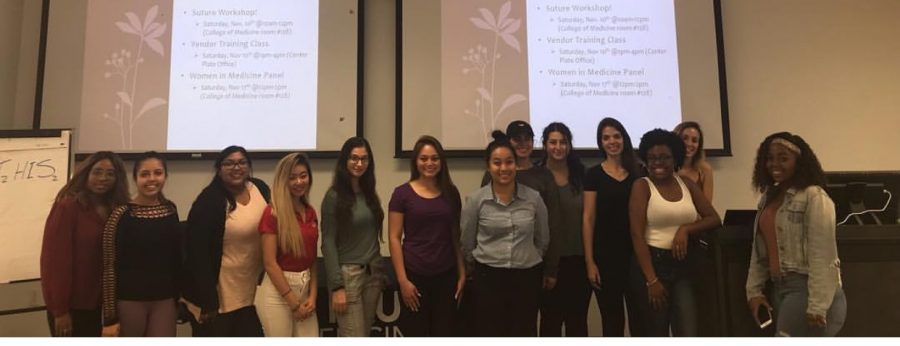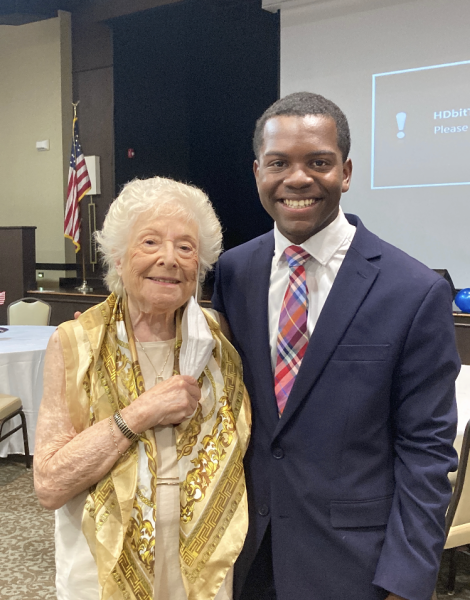How two clubs are creating opportunities for female pre-health students
American Medical Women’s Association pushes for more women’s visibility in STEM through discussions, activities, and workshops.
FAU’s American Medical Women’s Association undergraduate chapter. Photo courtesy of Marcy Oberstreet
March 20, 2019
Marcy Oberstreet is a biological sciences major, an aspiring doctor, and a mother.
She knows that having a family and practicing medicine could come with stigma and discrimination.
Regardless, she wants more women to pursue a career in medicine. That’s why she founded an undergraduate American Medical Women’s Association (AMWA) chapter at FAU.
“We need to change what it means to be a female in a male-dominated profession,” Oberstreet said.
AMWA has two chapters at FAU — undergraduate and graduate — that provide opportunities and experiences for women shooting for medical school. Some opportunities include shadowing, mentoring, and volunteering. There are about 364 members in both chapters combined, according to Owl Central.
The president of AMWA’s graduate chapter, Namrata Gadela, regularly hosts local female physicians at her meetings to hear about their professional journeys and experiences.
“People [in the club] are seeing that there are opportunities available if you work,” Gadela said.
Opportunities in AMWA
Oberstreet said she wants to give female undergraduate medical students more guidance and opportunities. That’s why she’s soon launching a shadowing program for her chapter, where members can hurry across hospital floors and learn what being in medicine is really like.

Besides offering the bedside experience, Oberstreet also wants to equip future doctors with contacts they can rely on after graduation through the chapter’s mentoring program, which is in the works.
Gadela’s graduate chapter is introducing some different initiatives.
Since her chapter’s members are already attending medical school, they can focus less on the application process and more on health issues facing the world.
Gadela said that one of the chapter’s most rewarding events was one where a local physician spoke about ways to prevent human trafficking.
On top of their existing “lunch talks” with local physicians and senior female faculty members, the graduate AMWA chapter wants to start a mentoring program of their own with third- and fourth-year medical students guiding first- and second-year ones.
“[Speakers] help give us advice on how to balance life and school, and show us a day in the life and how it’s possible to be a doctor,” she said.
Both presidents said that their members are mostly female, though men have participated — and are always welcome to.
Growing by the year: more women are becoming doctors
Elizabeth Blackwell, the first woman to earn her medical degree, was admitted to medical school as a joke. According to the Smithsonian, the school’s dean asked for the input of 150 men before allowing Blackwell to enter Geneva Medical College’s doors.
The men unanimously granted her access — but only because they thought the dean was kidding.
That was in 1847. 170 years later, in 2017, the percentage of women enrolled in medical school (50.7 percent) topped that of men for the first time, according to the Association of American Medical Colleges (AAMC). And it happened again last year, but with another first for women in medicine: more women applied to medical school than men, the AAMC found.
In recent years, the number of women doctors — particularly younger ones — has gradually increased, according to Athenahealth, a healthcare software company.
Gadela is optimistic of this recent pattern.
“STEM can benefit from a diversity of of people,” she said. “They will bring different innovations and new ideas.”
Despite the upward shift, most women in medicine, particularly soon-to-be and current mothers, say they face gender discrimination.
Reuters reported that 78 percent of surveyed female physicians faced discrimination because of “pregnancy, maternity leave, or breastfeeding.”
Being a mother and doctor can come with disadvantages, like “disrespectful treatment by support staff, being left out of administrative decisions, and not receiving pay or benefits equal to their male peers,” according to JAMA Internal Medicine.
As a mother, such consequences infuriate Oberstreet. The biggest issue plaguing women in medicine, she said, is the stereotype that, “if you think you want to start a family, you can’t. It’s messed up.”
Although women aren’t being let into medical school as jokes anymore, Oberstreet still wants to dispel the negative stereotypes pegged against them.
“We are women who are doctors,” she said, “and we can have a life outside of medicine.”
Kristen Grau is the features editor of the University Press. For information regarding this or other stories, email [email protected] or tweet her @_kristengrau.

















Marcy Overstreet • Aug 28, 2019 at 3:25 am
I didn’t found amwa undergrad chapter.